Micro-LED as a Promising Candidate for High-Speed Visible Light Communication
Abstract
1. Introduction
2. Theoretical Background of Micro-LEDs for VLC Applications
3. Factors Influencing the Modulation Bandwidth
3.1. Quantum Confined Stark Effect and Carrier Localization Effect
3.2. Crystal Orientation
4. Semipolar LED-Based VLC Applications
5. Micro-LED Array-Based VLC
6. Underwater Optical Wireless Communication
7. Improvement of Modulation Bandwidth
8. Overview of VLC Emerging over the Last Few Years and Its Future Prospects
9. Conclusions
Author Contributions
Funding
Acknowledgments
Conflicts of Interest
References
- Karunatilaka, D.; Zafar, F.; Kalavally, V.; Parthiban, R. LED Based Indoor Visible Light Communications: State of the Art. IEEE Commun. Surv. Tutor. 2015, 17, 1649–1678. [Google Scholar] [CrossRef]
- Rehman, S.U.; Ullah, S.; Chong, P.H.; Yongchareon, S.; Komosny, D. Visible Light Communication: A System Perspective—Overview and Challenges. Sensors 2019, 19, 1153. [Google Scholar] [CrossRef]
- Hussain, B.; Li, X.; Che, F.; Patrick Yue, C.; Wu, L. Visible Light Communication System Design and Link Budget Analysis. J. Lightwave Technol. 2015, 33, 5201–5209. [Google Scholar] [CrossRef]
- Ismail, S.N.; Salih, M.H. A review of visible light communication (VLC) technology. AIP Conf. Proc. 2020, 2213, 020289. [Google Scholar]
- Kadirvelu, S.B.V. Design and implementation of visible light communication system in indoor environment. ARPN J. Eng. Appl. Sci. 2015, 10, 2882–2886. [Google Scholar]
- Khan, L.U. Visible light communication: Applications, architecture, standardization and research challenges. Digit. Commun. Netw. 2017, 3, 78–88. [Google Scholar] [CrossRef]
- Zhao, S.; Xu, J.; Trescases, O. A Dimmable LED Driver for Visible Light Communication (VLC) Based on LLC Resonant DC-DC Converter Operating in Burst Mode. In Proceedings of the Twenty-Eighth Annual IEEE Applied Power Electronics Conference and Exposition (APEC), Long Beach, CA, USA, 17–21 March 2013; pp. 2144–2150. [Google Scholar]
- Ji, R.; Wang, S.; Liu, Q.; Lu, W. High-Speed Visible Light Communications: Enabling Technologies and State of the Art. Appl. Sci. 2018, 8, 589. [Google Scholar] [CrossRef]
- Chow, C.W.; Yeh, C.H.; Liu, Y.F.; Liu, Y. Improved modulation speed of LED visible light communication system integrated to main electricity network. Electron. Lett. 2011, 47, 867–868. [Google Scholar] [CrossRef]
- Alavi, S.E.; Amiri, I.S.; Supa'at, A.S.M.; Idrus, S.M. Indoor Data Transmission Over Ubiquitous Infrastructure of Powerline Cables and LED Lighting. J. Comput. Theor. Nanosci. 2015, 12, 599–604. [Google Scholar] [CrossRef]
- Uema, H.; Matsumura, T.; Saito, S.; Murata, Y. Research and Development on Underwater Visible Light Communication Systems. Electron. Commun. Jpn. 2015, 98, 9–13. [Google Scholar] [CrossRef]
- Watson, S.; Viola, S.; Giuliano, G.; Najda, S.; Perlin, P.; Suski, T.; Marona, L.; Leszczyński, M.; Wisniewski, P.; Czernecki, R.; et al. High Speed Visible Light Communication Using Blue GaN Laser Diodes; SPIE: Edinburgh, UK, 2016; Volume 9991. [Google Scholar]
- Arnon, S. Optimised optical wireless car-to-traffic-light communication. Trans. Emerg. Telecommun. Technol. 2014, 25, 660–665. [Google Scholar] [CrossRef]
- Luo, P.; Tsai, H.-M.; Viriyasitavat, W.; Minh, H.; Tang, X. Car-to-Car Visible Light Communications: Theory and Applications; Taylor & Francis Group: Boca Raton, FL, USA, 2017; pp. 253–282. [Google Scholar]
- Farr, N.; Bowen, A.; Ware, J.; Pontbriand, C.; Tivey, M. An Integrated, Underwater Optical/Acoustic Communications System. In Proceedings of the OCEANS'10 IEEE SYDNEY, Sydney, Australia, 24–27 May 2010; pp. 1–6. [Google Scholar]
- Qureshi, U.M.; Shaikh, F.K.; Aziz, Z.; Shah, S.M.Z.S.; Sheikh, A.A.; Felemban, E.; Qaisar, S.B. RF Path and Absorption Loss Estimation for Underwater Wireless Sensor Networks in Different Water Environments. Sensors 2016, 16, 890. [Google Scholar] [CrossRef]
- Doniec, M.; Vasilescu, I.; Chitre, M.; Detweiler, C.; Hoffmann-Kuhnt, M.; Rus, D. Aquaoptical: A Lightweight Device for High-Rate Long-Range Underwater Point-To-Point Communication. In Proceedings of the OCEANS 2009, Biloxi, MS, USA, 26–29 October 2009; pp. 1–6. [Google Scholar]
- Hossan, M.T.; Chowdhury, M.; Hasan, M.K.; Shahjalal, M.; Nguyen, T.; Le, N.-T.; Jang, Y.M. A New Vehicle Localization Scheme Based on Combined Optical Camera Communication and Photogrammetry. Mob. Inf. Syst. 2018, 2018, 14. [Google Scholar] [CrossRef]
- Zhu, S.; Lin, S.; Li, J.; Yu, Z.; Cao, H.; Yang, C.; Li, J.; Zhao, L. Influence of quantum confined Stark effect and carrier localization effect on modulation bandwidth for GaN-based LEDs. Appl. Phys. Lett. 2017, 111, 171105. [Google Scholar] [CrossRef]
- Ryou, J.H.; Lee, W.; Limb, J.; Yoo, D.; Liu, J.P.; Dupuis, R.D.; Wu, Z.H.; Fischer, A.M.; Ponce, F.A. Control of quantum-confined Stark effect in InGaN∕GaN multiple quantum well active region by p-type layer for III-nitride-based visible light emitting diodes. Appl. Phys. Lett. 2008, 92, 101113. [Google Scholar] [CrossRef]
- Zhang, Y.; Smith, R.M.; Hou, Y.; Xu, B.; Gong, Y.; Bai, J.; Wang, T. Stokes shift in semi-polar (11–22) InGaN/GaN multiple quantum wells. Appl. Phys. Lett. 2016, 108, 031108. [Google Scholar] [CrossRef]
- Piprek, J. Efficiency droop in nitride-based light-emitting diodes. Phys. Status Solidi 2010, 207, 2217–2225. [Google Scholar] [CrossRef]
- Kozlowski, G.; Schulz, S.; Corbett, B. Polarization matching design of InGaN-based semi-polar quantum wells—A case study of (112¯2) orientation. Appl. Phys. Lett. 2014, 104, 051128. [Google Scholar] [CrossRef]
- Chen, S.-W.H.; Huang, Y.-M.; Singh, K.J.; Hsu, Y.-C.; Liou, F.-J.; Song, J.; Choi, J.; Lee, P.-T.; Lin, C.-C.; Chen, Z.; et al. Full-color micro-LED display with high color stability using semipolar (20-21) InGaN LEDs and quantum-dot photoresist. Photon. Res. 2020, 8, 630–636. [Google Scholar] [CrossRef]
- Rosales, D.; Gil, B.; Bretagnon, T.; Guizal, B.; Izyumskaya, N.; Monavarian, M.; Zhang, F.; Okur, S.; Avrutin, V.; Özgür, Ü.; et al. Recombination dynamics of excitons with low non-radiative component in semi-polar (10-11)-oriented GaN/AlGaN multiple quantum wells. J. Appl. Phys. 2014, 116, 093517. [Google Scholar] [CrossRef]
- Rosales, D.; Gil, B.; Bretagnon, T.; Guizal, B.; Zhang, F.; Okur, S.; Monavarian, M.; Izyumskaya, N.; Avrutin, V.; Özgür, Ü.; et al. Excitonic recombination dynamics in non-polar GaN/AlGaN quantum wells. J. Appl. Phys. 2014, 115, 073510. [Google Scholar] [CrossRef]
- Wu, T.; Sher, C.-W.; Lin, Y.; Lee, C.-F.; Liang, S.; Lu, Y.; Huang Chen, S.-W.; Guo, W.; Kuo, H.-C.; Chen, Z. Mini-LED and Micro-LED: Promising Candidates for the Next Generation Display Technology. Appl. Sci. 2018, 8, 1557. [Google Scholar] [CrossRef]
- Haemmer, M.; Roycroft, B.; Akhter, M.; Dinh, D.V.; Quan, Z.; Zhao, J.; Parbrook, P.J.; Corbett, B. Size-Dependent Bandwidth of Semipolar (11-22) Light-Emitting-Diodes. IEEE Photonics Technol. Lett. 2018, 30, 439–442. [Google Scholar] [CrossRef]
- Shi, J.; Sheu, J.; Chen, C.; Lin, G.; Lai, W. High-Speed GaN-Based Green Light-Emitting Diodes With Partially n-Doped Active Layers and Current-Confined Apertures. IEEE Electron Device Lett. 2008, 29, 158–160. [Google Scholar] [CrossRef]
- Liao, C.; Chang, Y.; Ho, C.; Wu, M. High-Speed GaN-Based Blue Light-Emitting Diodes With Gallium-Doped ZnO Current Spreading Layer. IEEE Electron Device Lett. 2013, 34, 611–613. [Google Scholar] [CrossRef]
- Liao, C.; Ho, C.; Chang, Y.; Wu, C.; Wu, M. High-Speed Light-Emitting Diodes Emitting at 500 nm With 463-MHz Modulation Bandwidth. IEEE Electron Device Lett. 2014, 35, 563–565. [Google Scholar] [CrossRef]
- McKendry, J.J.D.; Massoubre, D.; Zhang, S.; Rae, B.R.; Green, R.P.; Gu, E.; Henderson, R.K.; Kelly, A.E.; Dawson, M.D. Visible-Light Communications Using a CMOS-Controlled Micro-Light- Emitting-Diode Array. J. Lightwave Technol. 2012, 30, 61–67. [Google Scholar] [CrossRef]
- Wun, J.; Lin, C.; Chen, W.; Sheu, J.; Lin, C.; Li, Y.; Bowers, J.E.; Shi, J.; Vinogradov, J.; Kruglov, R.; et al. GaN-Based Miniaturized Cyan Light-Emitting Diodes on a Patterned Sapphire Substrate With Improved Fiber Coupling for Very High-Speed Plastic Optical Fiber Communication. IEEE Photonics J. 2012, 4, 1520–1529. [Google Scholar] [CrossRef]
- Windisch, R.; Knobloch, A.; Kuijk, M.; Rooman, C.; Dutta, B.; Kiesel, P.; Borghs, G.; Dohler, G.H.; Heremans, P. Large-signal-modulation of high-efficiency light-emitting diodes for optical communication. IEEE J. Quantum Electron. 2000, 36, 1445–1453. [Google Scholar] [CrossRef]
- Zhu, S.; Yu, Z.; Liu, L.; Yang, C.; Cao, H.; Xi, X.; Li, J.; Zhao, L. Enhancing the spontaneous emission rate by modulating carrier distribution in GaN-based surface plasmon light-emitting diodes. Opt. Express 2017, 25, 9617–9627. [Google Scholar] [CrossRef]
- Huang, S.-Y.; Horng, R.-H.; Shi, J.-W.; Kuo, H.-C.; Wuu, D.-S. High-Performance InGaN-Based Green Resonant-Cavity Light-Emitting Diodes for Plastic Optical Fiber Applications. J. Lightwave Technol. 2009, 27, 4084–4090. [Google Scholar] [CrossRef]
- Shi, J.; Chi, K.; Wun, J.; Bowers, J.E.; Shih, Y.; Sheu, J. III-Nitride-Based Cyan Light-Emitting Diodes With GHz Bandwidth for High-Speed Visible Light Communication. IEEE Electron Device Lett. 2016, 37, 894–897. [Google Scholar] [CrossRef]
- Maier, M.; Köhler, K.; Kunzer, M.; Pletschen, W.; Wagner, J. Reduced nonthermal rollover of wide-well GaInN light-emitting diodes. Appl. Phys. Lett. 2009, 94, 041103. [Google Scholar] [CrossRef]
- Zhu, S.-C.; Yu, Z.-G.; Zhao, L.-X.; Wang, J.-X.; Li, J.-M. Enhancement of the modulation bandwidth for GaN-based light-emitting diode by surface plasmons. Opt. Express 2015, 23, 13752–13760. [Google Scholar] [CrossRef]
- Huang, S.; Xian, Y.; Fan, B.; Zheng, Z.; Chen, Z.; Jia, W.; Jiang, H.; Wang, G. Contrary luminescence behaviors of InGaN/GaN light emitting diodes caused by carrier tunneling leakage. J. Appl. Phys. 2011, 110, 064511. [Google Scholar] [CrossRef]
- Li, Y.L.; Huang, Y.R.; Lai, Y.H. Efficiency droop behaviors of InGaN∕GaN multiple-quantum-well light-emitting diodes with varying quantum well thickness. Appl. Phys. Lett. 2007, 91, 181113. [Google Scholar] [CrossRef]
- Lefebvre, P.; Allègre, J.; Mathieu, H. Recombination dynamics of excitons in III-nitride layers and quantum wells. Mater. Sci. Eng. B 1999, 59, 307–314. [Google Scholar] [CrossRef]
- Malinauskas, T.; Miasojedovas, S.; Aleksiejūnas, R.; Juršėnas, S.; Jarašiūnas, K.; Nomura, M.; Arakawa, Y.; Shimura, T.; Kuroda, K. Direct study of nonlinear carrier recombination in InGaN quantum well structures. Phys. Status Solidi C 2011, 8, 2381–2383. [Google Scholar] [CrossRef]
- Mickevičius, J.; Tamulaitis, G.; Kuokštis, E.; Liu, K.; Shur, M.S.; Zhang, J.P.; Gaska, R. Well-width-dependent carrier lifetime in AlGaN∕AlGaN quantum wells. Appl. Phys. Lett. 2007, 90, 131907. [Google Scholar] [CrossRef]
- Cho, J.; Schubert, E.F.; Kim, J.K. Efficiency droop in light-emitting diodes: Challenges and countermeasures. Laser Photonics Rev. 2013, 7, 408–421. [Google Scholar] [CrossRef]
- Weisbuch, C.; Piccardo, M.; Martinelli, L.; Iveland, J.; Peretti, J.; Speck, J.S. The efficiency challenge of nitride light-emitting diodes for lighting. Phys. Status Solidi A 2015, 212, 899–913. [Google Scholar] [CrossRef]
- Okur, S.; Nami, M.; Rishinaramangalam, A.K.; Oh, S.H.; DenBaars, S.P.; Liu, S.; Brener, I.; Feezell, D.F. Internal quantum efficiency and carrier dynamics in semipolar (20-2-1) InGaN/GaN light-emitting diodes. Opt. Express 2017, 25, 2178–2186. [Google Scholar] [CrossRef]
- Rashidi, A.; Monavarian, M.; Aragon, A.; Okur, S.; Nami, M.; Rishinaramangalam, A.; Mishkat-Ul-Masabih, S.; Feezell, D. High-Speed Nonpolar InGaN/GaN LEDs for Visible-Light Communication. IEEE Photonics Technol. Lett. 2017, 29, 381–384. [Google Scholar] [CrossRef]
- Romanov, A.E.; Baker, T.J.; Nakamura, S.; Speck, J.S. Strain-induced polarization in wurtzite III-nitride semipolar layers. J. Appl. Phys. 2006, 100, 023522. [Google Scholar] [CrossRef]
- Monavarian, M.; Rashidi, A.; Aragon, A.; Oh, S.H.; Nami, M.; DenBaars, S.P.; Feezell, D. Explanation of low efficiency droop in semipolar (20-2-1) InGaN/GaN LEDs through evaluation of carrier recombination coefficients. Opt. Express 2017, 25, 19343–19353. [Google Scholar] [CrossRef]
- Monavarian, M.; Rashidi, A.; Aragon, A.A.; Oh, S.H.; Rishinaramangalam, A.K.; DenBaars, S.P.; Feezell, D. Impact of crystal orientation on the modulation bandwidth of InGaN/GaN light-emitting diodes. Appl. Phys. Lett. 2018, 112, 041104. [Google Scholar] [CrossRef]
- David, A.; Grundmann, M.J. Droop in InGaN light-emitting diodes: A differential carrier lifetime analysis. Appl. Phys. Lett. 2010, 96, 103504. [Google Scholar] [CrossRef]
- Yevick, D.; Streifer, W. Radiative and nonradiative recombination law in lightly doped InGaAsP lasers. Electron. Lett. 1983, 19, 1012–1014. [Google Scholar] [CrossRef]
- Feezell, D.F.; Speck, J.S.; DenBaars, S.P.; Nakamura, S. Semipolar (20-2-1) InGaN/GaN Light-Emitting Diodes for High-Efficiency Solid-State Lighting. J. Disp. Technol. 2013, 9, 190–198. [Google Scholar] [CrossRef]
- Rajpalke, M.K.; Roul, B.; Kumar, M.; Bhat, T.N.; Sinha, N.; Krupanidhi, S.B. Structural and optical properties of nonpolar (11−20) a-plane GaN grown on (1−102) r-plane sapphire substrate by plasma-assisted molecular beam epitaxy. Scr. Mater. 2011, 65, 33–36. [Google Scholar] [CrossRef]
- Mukundan, S.; Mohan, L.; Chandan, G.; Roul, B.; Krupanidhi, S.B. Semipolar and nonpolar GaN epi-films grown on m-sapphire by plasma assisted molecular beam epitaxy. J. Appl. Phys. 2014, 116, 204502. [Google Scholar] [CrossRef]
- Dinh, D.V.; Quan, Z.; Roycroft, B.; Parbrook, P.J.; Corbett, B. GHz bandwidth semipolar (11-22) InGaN/GaN light-emitting diodes. Opt. Lett. 2016, 41, 5752–5755. [Google Scholar] [CrossRef]
- Gong, Z.; Jin, S.; Chen, Y.; McKendry, J.; Massoubre, D.; Watson, I.M.; Gu, E.; Dawson, M.D. Size-dependent light output, spectral shift, and self-heating of 400 nm InGaN light-emitting diodes. J. Appl. Phys. 2010, 107, 013103. [Google Scholar] [CrossRef]
- Haggar, J.I.H.; Cai, Y.; Ghataora, S.S.; Smith, R.M.; Bai, J.; Wang, T. High Modulation Bandwidth of Semipolar (11–22) InGaN/GaN LEDs with Long Wavelength Emission. ACS Appl. Electron. Mater. 2020, 2, 2363–2368. [Google Scholar] [CrossRef]
- Chen, S.-W.H.; Huang, Y.-M.; Chang, Y.-H.; Lin, Y.; Liou, F.-J.; Hsu, Y.-C.; Song, J.; Choi, J.; Chow, C.-W.; Lin, C.-C.; et al. High-Bandwidth Green Semipolar (20–21) InGaN/GaN Micro Light-Emitting Diodes for Visible Light Communication. ACS Photonics 2020, 7, 2228–2235. [Google Scholar] [CrossRef]
- Hsu, C.-W.; Yeh, C.-H.; Chow, C.-W. Using adaptive equalization and polarization-multiplexing technology for gigabit-per-second phosphor-LED wireless visible light communication. Opt. Laser Technol. 2018, 104, 206–209. [Google Scholar] [CrossRef]
- Quan, Z.; Dinh, D.V.; Presa, S.; Roycroft, B.; Foley, A.; Akhter, M.; Mahony, D.O.; Maaskant, P.P.; Caliebe, M.; Scholz, F.; et al. High Bandwidth Freestanding Semipolar (11–22) InGaN/GaN Light-Emitting Diodes. IEEE Photonics J. 2016, 8, 1–8. [Google Scholar] [CrossRef]
- Shen, C.; Ng, T.K.; Leonard, J.T.; Pourhashemi, A.; Nakamura, S.; DenBaars, S.P.; Speck, J.S.; Alyamani, A.Y.; El-desouki, M.M.; Ooi, B.S. High-brightness semipolar (202-1) blue InGaN/GaN superluminescent diodes for droop-free solid-state lighting and visible-light communications. Opt. Lett. 2016, 41, 2608–2611. [Google Scholar] [CrossRef]
- Corbett, B.; Quan, Z.; Dinh, D.V.; Kozlowski, G.; O'Mahony, D.; Akhter, M.; Schulz, S.; Parbrook, P.; Maaskant, P.; Caliebe, M.; et al. Development of Semipolar (11-22) LEDs on GaN Templates; SPIE: San Francisco, CA, USA, 2016; Volume 9768. [Google Scholar]
- Khoury, M.; Li, H.; Li, P.; Chow, Y.C.; Bonef, B.; Zhang, H.; Wong, M.S.; Pinna, S.; Song, J.; Choi, J.; et al. Polarized monolithic white semipolar (20–21) InGaN light-emitting diodes grown on high quality (20–21) GaN/sapphire templates and its application to visible light communication. Nano Energy 2020, 67, 104236. [Google Scholar] [CrossRef]
- Li, X.; Wu, L.; Liu, Z.; Hussain, B.; Chong, W.C.; Lau, K.M.; Yue, C.P. Design and Characterization of Active Matrix LED Microdisplays With Embedded Visible Light Communication Transmitter. J. Lightwave Technol. 2016, 34, 3449–3457. [Google Scholar] [CrossRef]
- Rajbhandari, S.; McKendry, J.J.D.; Herrnsdorf, J.; Chun, H.; Faulkner, G.; Haas, H.; Watson, I.M.; O’Brien, D.; Dawson, M.D. A review of gallium nitride LEDs for multi-gigabit-per-second visible light data communications. Semicond. Sci. Technol. 2017, 32, 023001. [Google Scholar] [CrossRef]
- Choi, H.W.; Liu, C.; Gu, E.; McConnell, G.; Girkin, J.M.; Watson, I.M.; Dawson, M.D. GaN micro-light-emitting diode arrays with monolithically integrated sapphire microlenses. Appl. Phys. Lett. 2004, 84, 2253–2255. [Google Scholar] [CrossRef]
- Lin, H.-Y.; Sher, C.-W.; Hsieh, D.-H.; Chen, X.-Y.; Chen, H.-M.P.; Chen, T.-M.; Lau, K.-M.; Chen, C.-H.; Lin, C.-C.; Kuo, H.-C. Optical cross-talk reduction in a quantum-dot-based full-color micro-light-emitting-diode display by a lithographic-fabricated photoresist mold. Photon. Res. 2017, 5, 411–416. [Google Scholar] [CrossRef]
- Bui, H.Q.; Velpula, R.T.; Jain, B.; Aref, O.H.; Nguyen, H.-D.; Lenka, T.R.; Nguyen, H.P. Full-Color InGaN/AlGaN Nanowire Micro Light-Emitting Diodes Grown by Molecular Beam Epitaxy: A Promising Candidate for Next Generation Micro Displays. Micromachines 2019, 10, 492. [Google Scholar] [CrossRef]
- Xuan, T.; Shi, S.; Wang, L.; Kuo, H.-C.; Xie, R.-J. Inkjet-Printed Quantum Dot Color Conversion Films for High-Resolution and Full-Color Micro Light-Emitting Diode Displays. J. Phys. Chem. Lett. 2020, 11, 5184–5191. [Google Scholar] [CrossRef]
- Zhang, S.; Gong, Z.; McKendry, J.J.D.; Watson, S.; Cogman, A.; Xie, E.; Tian, P.; Gu, E.; Chen, Z.; Zhang, G.; et al. CMOS-Controlled Color-Tunable Smart Display. IEEE Photonics J. 2012, 4, 1639–1646. [Google Scholar] [CrossRef]
- Zhang, H.; Rogers, J.A. Recent Advances in Flexible Inorganic Light Emitting Diodes: From Materials Design to Integrated Optoelectronic Platforms. Adv. Opt. Mater. 2019, 7, 1800936. [Google Scholar] [CrossRef]
- Kim, H.-s.; Brueckner, E.; Song, J.; Li, Y.; Kim, S.; Lu, C.; Sulkin, J.; Choquette, K.; Huang, Y.; Nuzzo, R.G.; et al. Unusual strategies for using indium gallium nitride grown on silicon (111) for solid-state lighting. Natl. Acad. Sci. 2011, 108, 10072. [Google Scholar] [CrossRef]
- Ferreira, R.X.G.; Xie, E.; McKendry, J.J.D.; Rajbhandari, S.; Chun, H.; Faulkner, G.; Watson, S.; Kelly, A.E.; Gu, E.; Penty, R.V.; et al. High Bandwidth GaN-Based Micro-LEDs for Multi-Gb/s Visible Light Communications. IEEE Photonics Technol. Lett. 2016, 28, 2023–2026. [Google Scholar] [CrossRef]
- Islim, M.S.; Ferreira, R.X.; He, X.; Xie, E.; Videv, S.; Viola, S.; Watson, S.; Bamiedakis, N.; Penty, R.V.; White, I.H.; et al. Towards 10 Gb/s orthogonal frequency division multiplexing-based visible light communication using a GaN violet micro-LED. Photon. Res. 2017, 5, A35–A43. [Google Scholar] [CrossRef]
- Carreira, J.F.C.; Xie, E.; Bian, R.; Chen, C.; McKendry, J.J.D.; Guilhabert, B.; Haas, H.; Gu, E.; Dawson, M.D. On-chip GaN-based dual-color micro-LED arrays and their application in visible light communication. Opt. Express 2019, 27, A1517–A1528. [Google Scholar] [CrossRef] [PubMed]
- Ryou, J.; Yoder, P.D.; Liu, J.; Lochner, Z.; Kim, H.; Choi, S.; Kim, H.J.; Dupuis, R.D. Control of Quantum-Confined Stark Effect in InGaN-Based Quantum Wells. IEEE J. Sel. Top. Quantum Electron. 2009, 15, 1080–1091. [Google Scholar] [CrossRef]
- Xie, E.; He, X.; Islim, M.S.; Purwita, A.A.; McKendry, J.J.D.; Gu, E.; Haas, H.; Dawson, M.D. High-Speed Visible Light Communication Based on a III-Nitride Series-Biased Micro-LED Array. J. Lightwave Technol. 2019, 37, 1180–1186. [Google Scholar] [CrossRef]
- Tien, C.; Kuo, C.; Wuu, D.; Horng, R. Improved Optoelectronic Performance of High-Voltage Ultraviolet Light-Emitting Diodes Through Electrode Designs. IEEE Trans. Electron Devices 2017, 64, 4526–4531. [Google Scholar] [CrossRef]
- Huang, Y.; Guo, Z.; Huang, H.; Sun, H. Influence of Current Density and Capacitance on the Bandwidth of VLC LED. IEEE Photonics Technol. Lett. 2018, 30, 773–776. [Google Scholar] [CrossRef]
- Perin, J.K.; Sharif, M.; Kahn, J.M. Sensitivity Improvement in 100 Gb/s-per-Wavelength Links Using Semiconductor Optical Amplifiers or Avalanche Photodiodes. J. Lightwave Technol. 2016, 34, 5542–5553. [Google Scholar] [CrossRef]
- Liu, X.; Yi, S.; Zhou, X.; Zhang, S.; Fang, Z.; Qiu, Z.-J.; Hu, L.; Cong, C.; Zheng, L.; Liu, R.; et al. Laser-based white-light source for high-speed underwater wireless optical communication and high-efficiency underwater solid-state lighting. Opt. Express 2018, 26, 19259–19274. [Google Scholar] [CrossRef]
- Xu, J.; Kong, M.; Lin, A.; Song, Y.; Yu, X.; Qu, F.; Han, J.; Deng, N. OFDM-based broadband underwater wireless optical communication system using a compact blue LED. Opt. Commun. 2016, 369, 100–105. [Google Scholar] [CrossRef]
- Zeng, Z.; Fu, S.; Zhang, H.; Dong, Y.; Cheng, J. A Survey of Underwater Optical Wireless Communications. IEEE Commun. Surv. Tutor. 2017, 19, 204–238. [Google Scholar] [CrossRef]
- Fan, Z.Y.; Lin, J.Y.; Jiang, H.X. III-nitride micro-emitter arrays: Development and applications. J. Phys. D Appl. Phys. 2008, 41, 094001. [Google Scholar] [CrossRef]
- Schubert, E.F. Light-Emitting Diodes, 2nd ed.; Cambridge University Press: Cambridge, UK, 2006. [Google Scholar]
- Wei, Z.; Zhang, L.; Wang, L.; Chen, C.-J.; Pepe, A.; Liu, X.; Chen, K.-C.; Wu, M.-C.; Dong, Y.; Wang, L.; et al. 2 Gbps/3 m air–underwater optical wireless communication based on a single-layer quantum dot blue micro-LED. Opt. Lett. 2020, 45, 2616–2619. [Google Scholar] [CrossRef]
- Tian, P.; Liu, X.; Yi, S.; Huang, Y.; Zhang, S.; Zhou, X.; Hu, L.; Zheng, L.; Liu, R. High-speed underwater optical wireless communication using a blue GaN-based micro-LED. Opt. Express 2017, 25, 1193–1201. [Google Scholar] [CrossRef]
- Wang, Y.; Wang, Y.; Chi, N.; Yu, J.; Shang, H. Demonstration of 575-Mb/s downlink and 225-Mb/s uplink bi-directional SCM-WDM visible light communication using RGB LED and phosphor-based LED. Opt. Express 2013, 21, 1203–1208. [Google Scholar] [CrossRef]
- Yeh, C.-H.; Liu, Y.-L.; Chow, C.-W. Real-time white-light phosphor-LED visible light communication (VLC) with compact size. Opt. Express 2013, 21, 26192–26197. [Google Scholar] [CrossRef]
- Xiao, X.; Tang, H.; Zhang, T.; Chen, W.; Chen, W.; Wu, D.; Wang, R.; Wang, K. Improving the modulation bandwidth of LED by CdSe/ZnS quantum dots for visible light communication. Opt. Express 2016, 24, 21577–21586. [Google Scholar] [CrossRef]
- Laurand, N.; Guilhabert, B.; McKendry, J.; Kelly, A.E.; Rae, B.; Massoubre, D.; Gong, Z.; Gu, E.; Henderson, R.; Dawson, M.D. Colloidal quantum dot nanocomposites for visible wavelength conversion of modulated optical signals. Opt. Mater. Express 2012, 2, 250–260. [Google Scholar] [CrossRef]
- Okamoto, K.; Niki, I.; Scherer, A.; Narukawa, Y.; Mukai, T.; Kawakami, Y. Surface plasmon enhanced spontaneous emission rate of InGaN∕GaN quantum wells probed by time-resolved photoluminescence spectroscopy. Appl. Phys. Lett. 2005, 87, 071102. [Google Scholar] [CrossRef]
- Okamoto, K.; Niki, I.; Shvartser, A.; Narukawa, Y.; Mukai, T.; Scherer, A. Surface-plasmon-enhanced light emitters based on InGaN quantum wells. Nat. Mater. 2004, 3, 601–605. [Google Scholar] [CrossRef]
- Purcell, E.M. Spontaneous Emission Probabilities at Radio Frequencies. In Confined Electrons and Photons: New Physics and Applications; Burstein, E., Weisbuch, C., Eds.; Springer US: Boston, MA, USA, 1995; p. 839. [Google Scholar]
- Sun, G.; Khurgin, J.B.; Soref, R.A. Practical enhancement of photoluminescence by metal nanoparticles. Appl. Phys. Lett. 2009, 94, 101103. [Google Scholar] [CrossRef]
- Langer, K.; Vucic, J.; Kottke, C.; Rosal, L.F.d.; Nerreter, S.; Walewski, J. Advances and Prospects in High-Speed Information Broadcast Using Phosphorescent White-Light LEDs. In Proceedings of the 2009 11th International Conference on Transparent Optical Networks, Azores, Portugal, 28 June–2 July 2009; pp. 1–6. [Google Scholar]
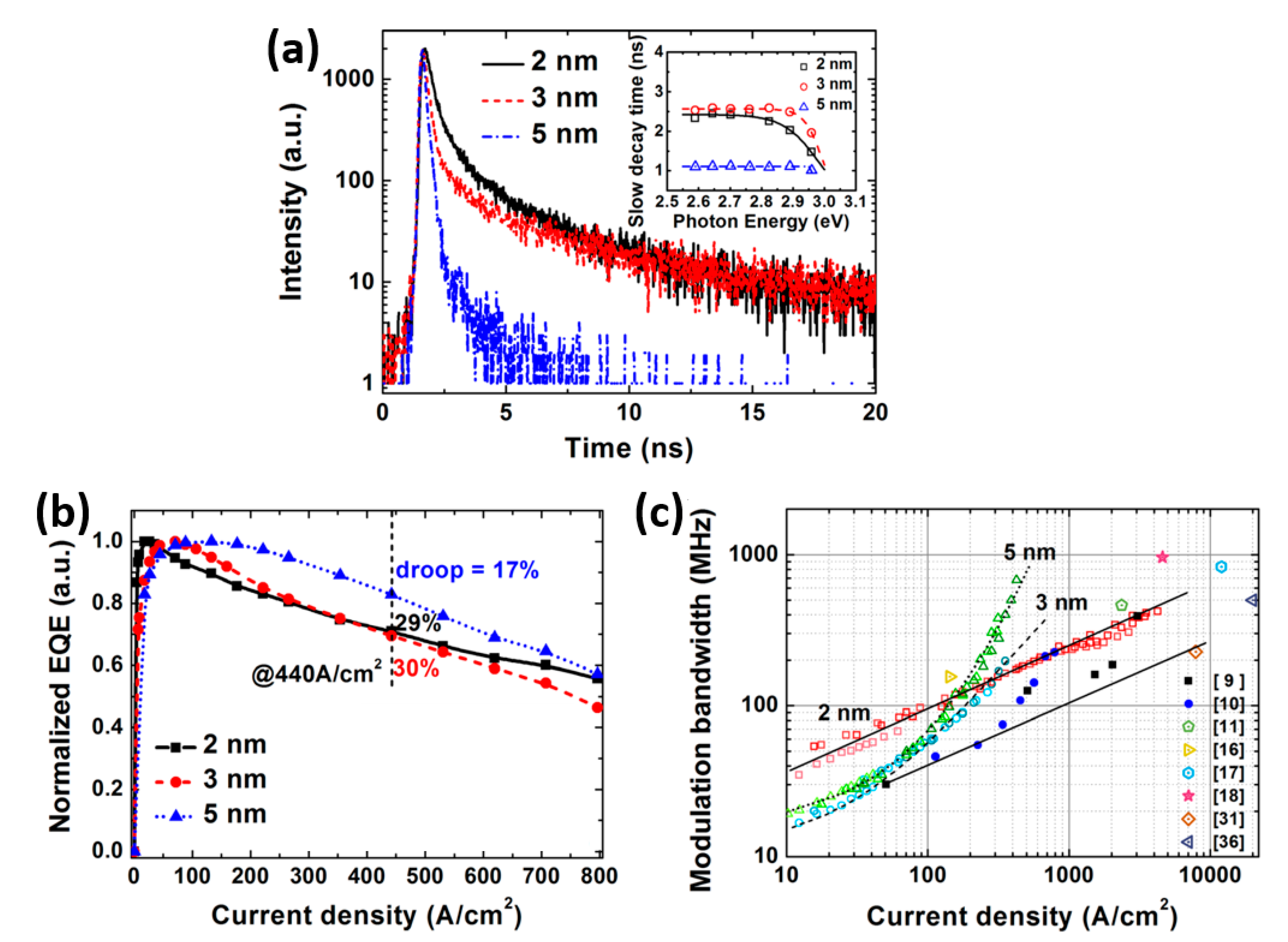

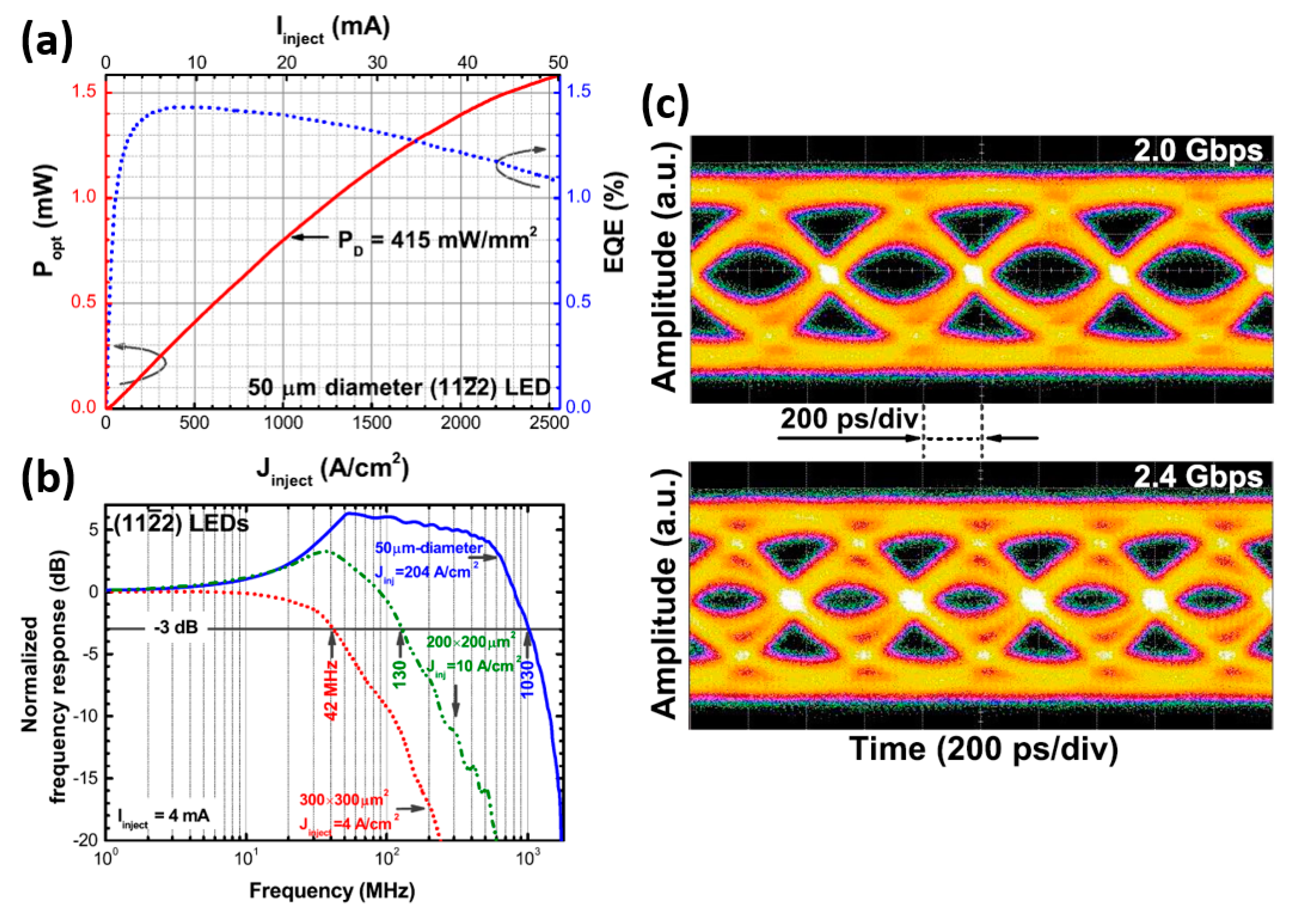
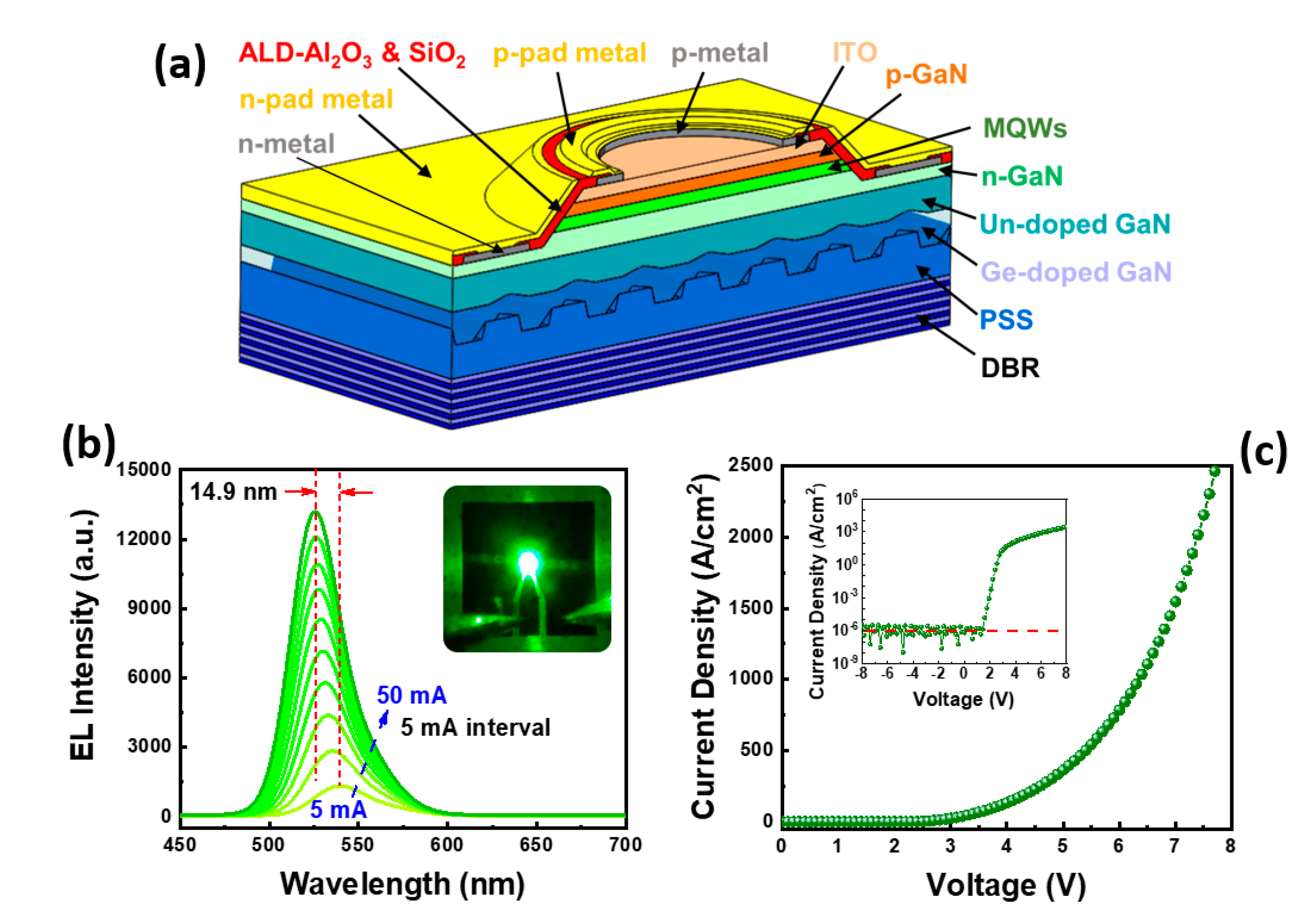
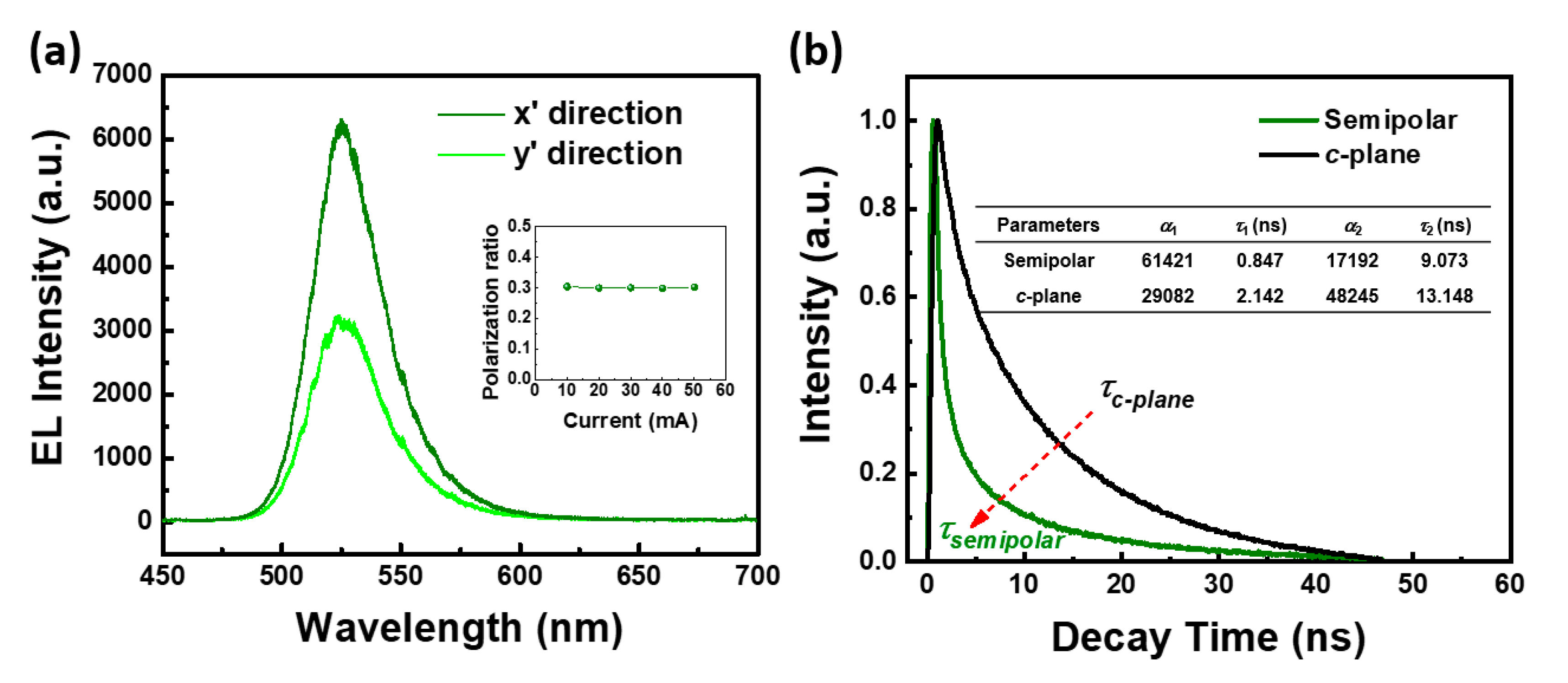

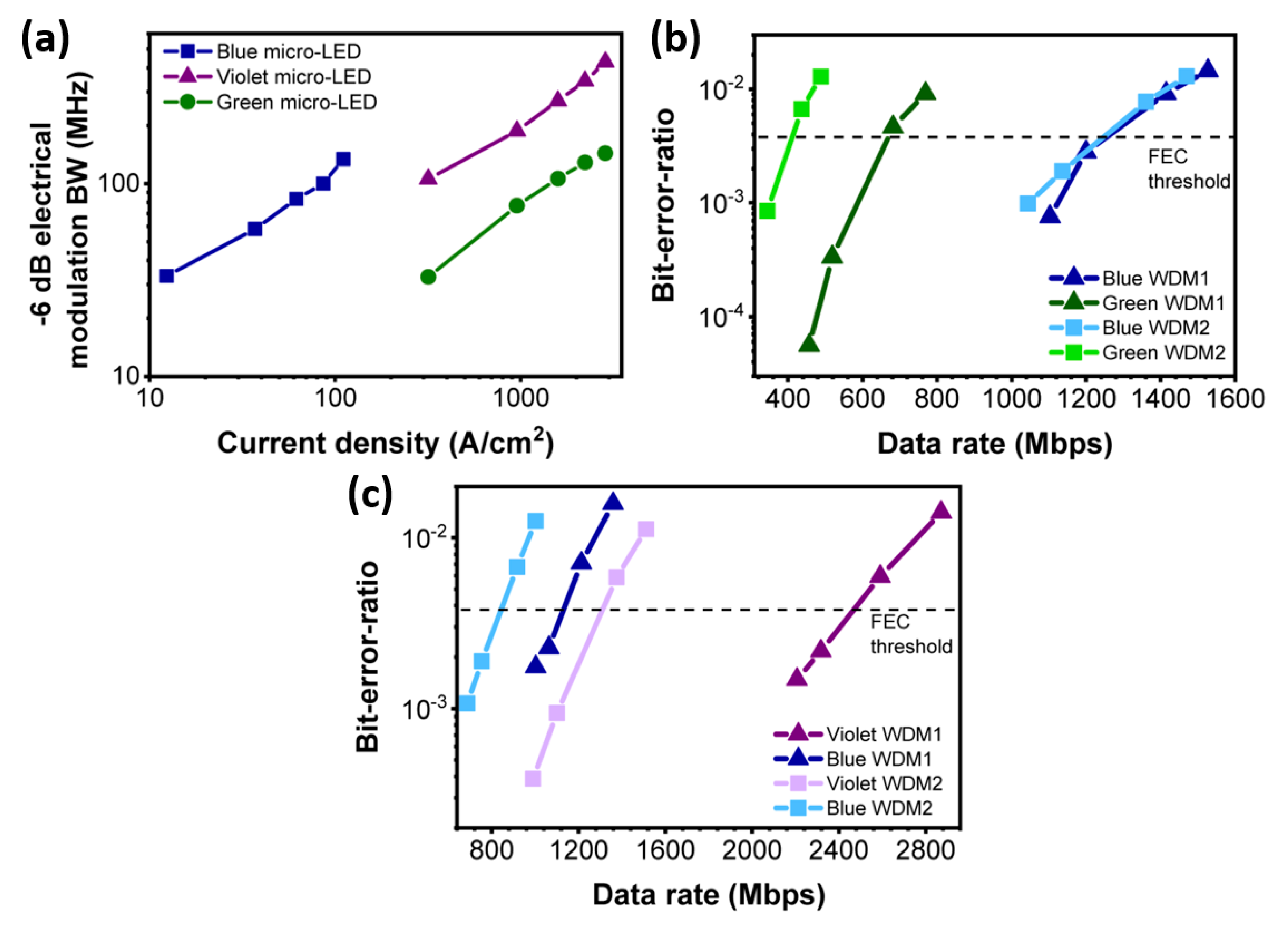
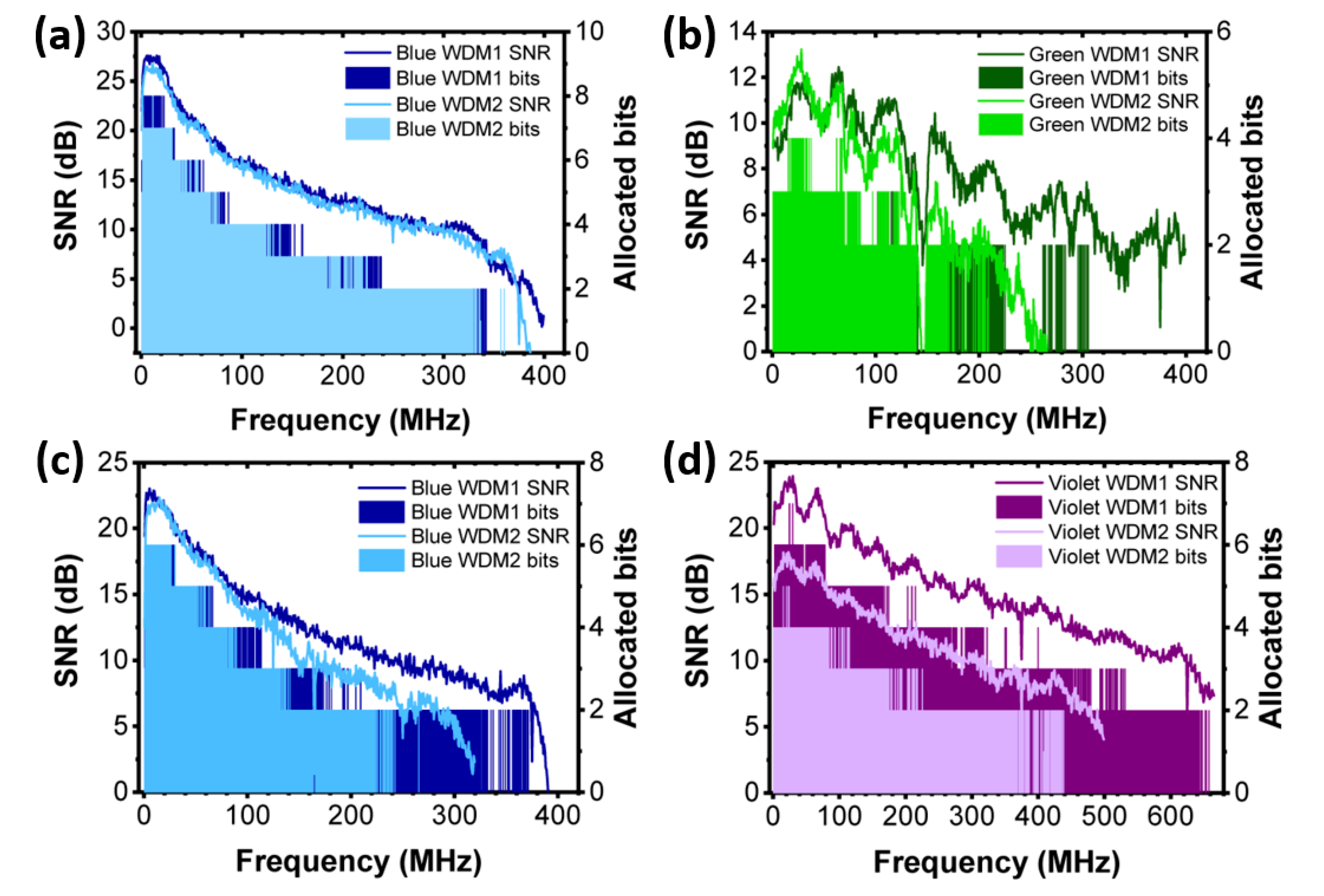
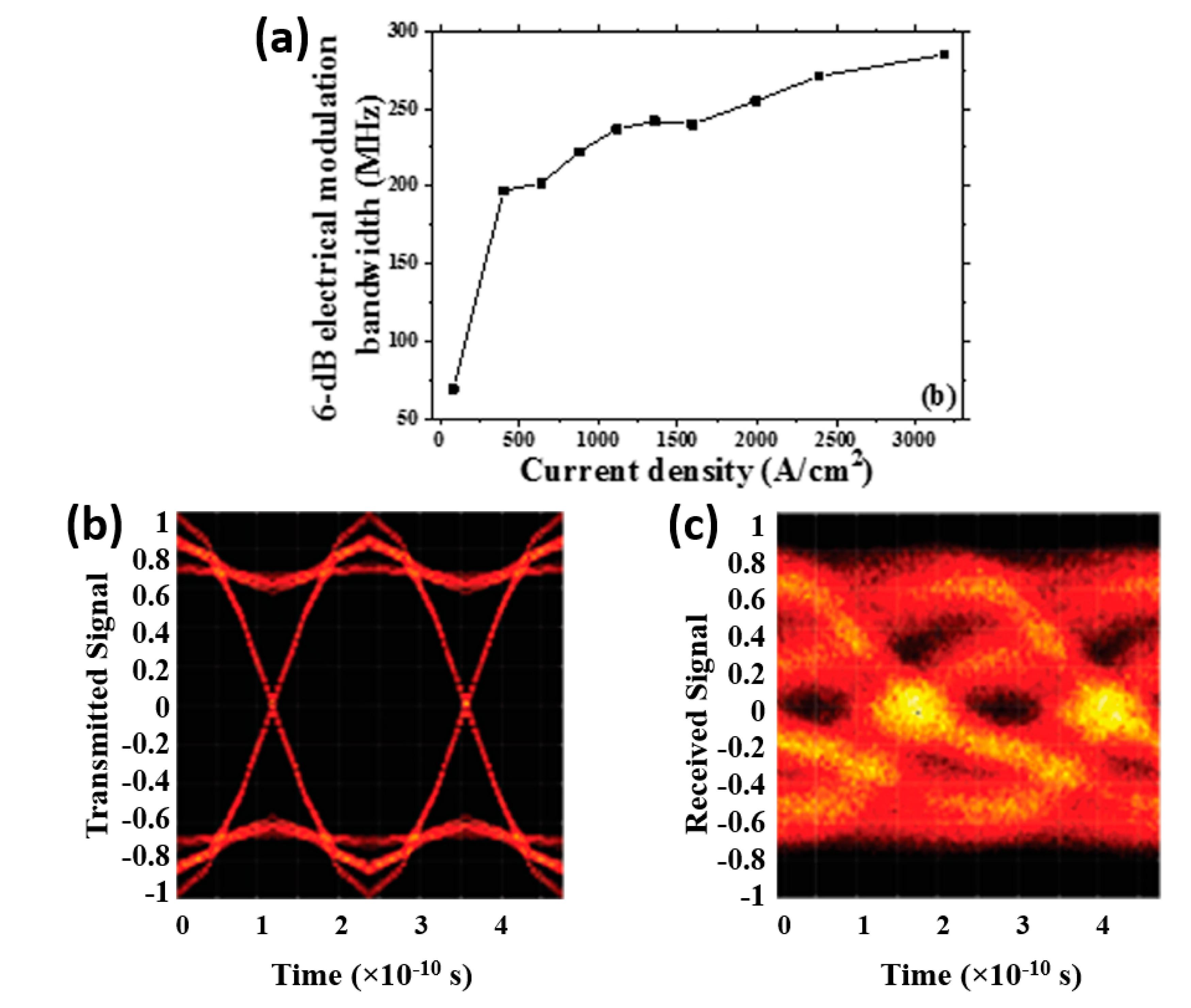
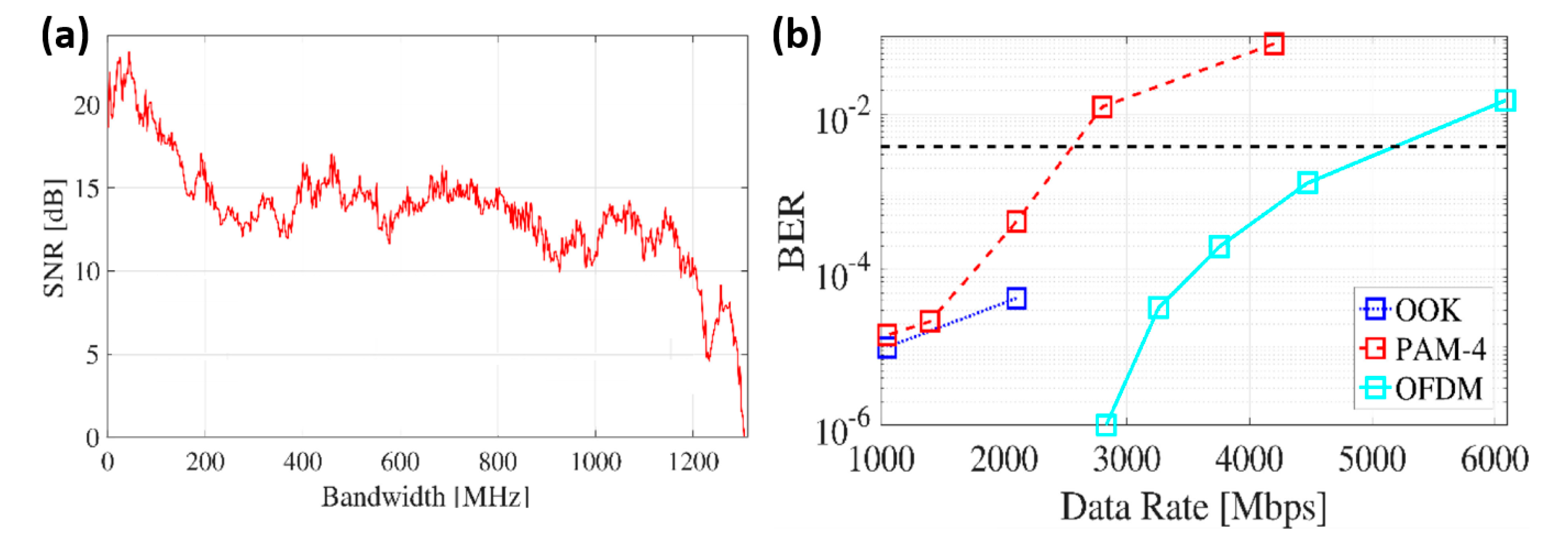
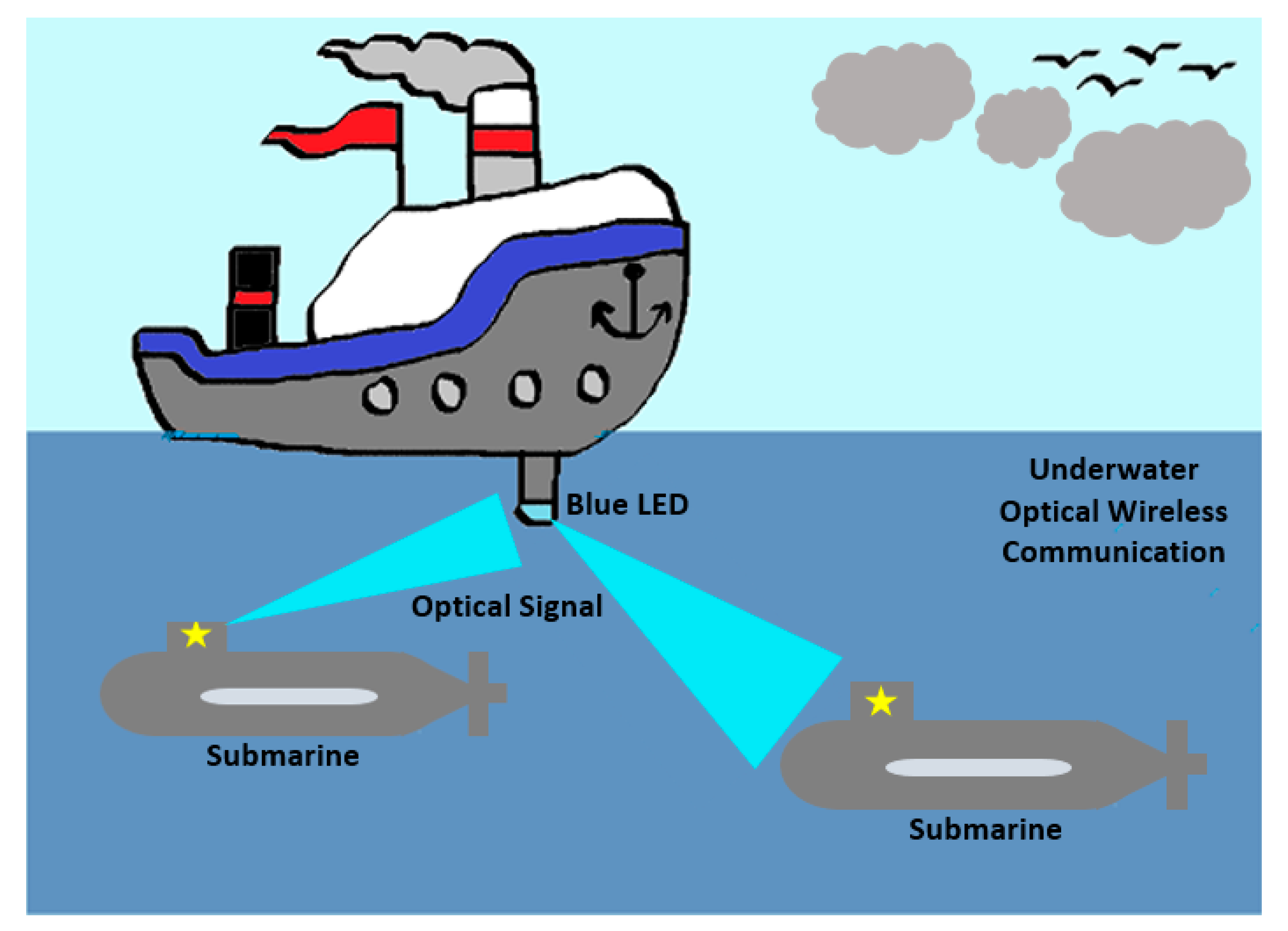
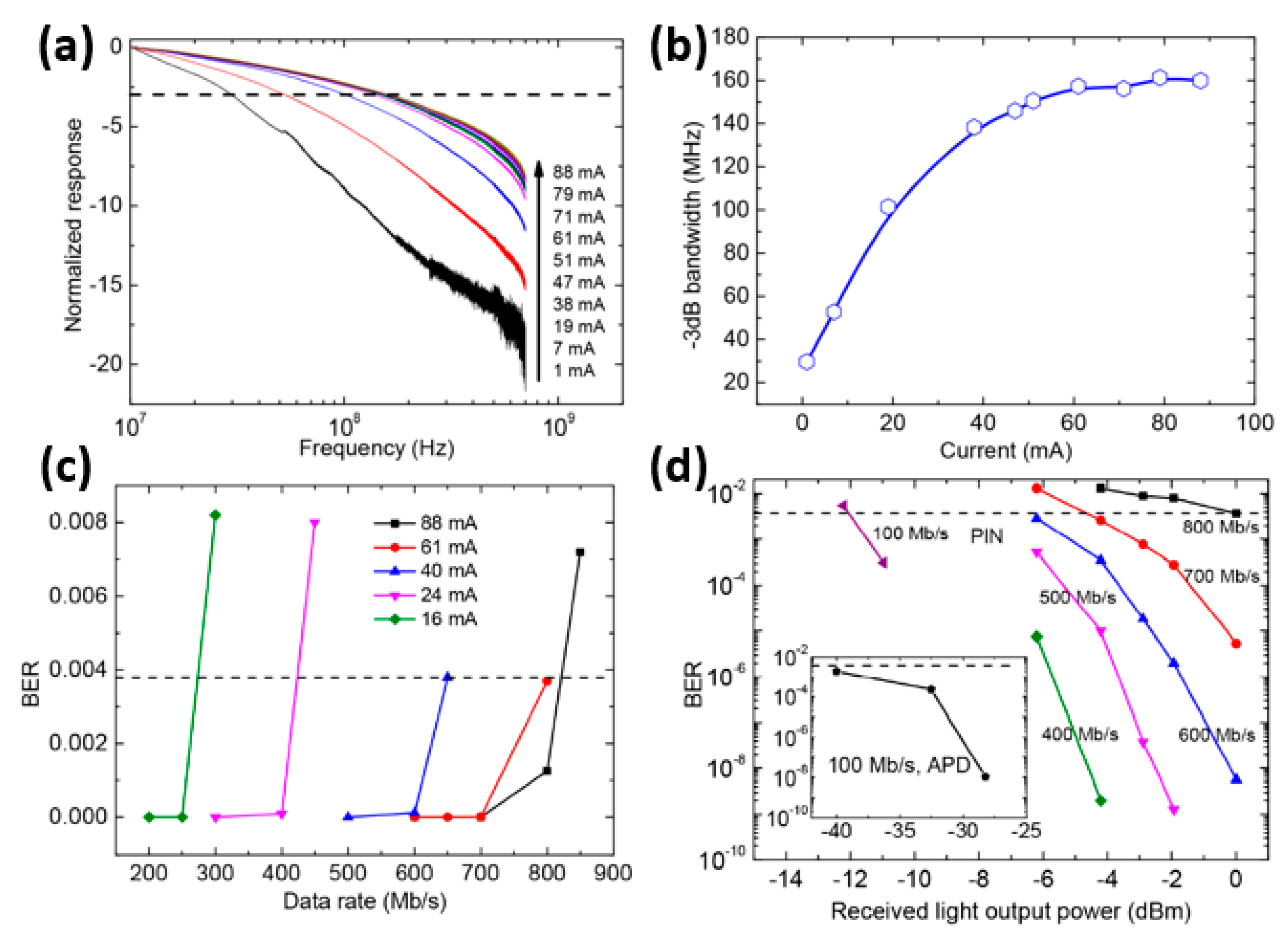

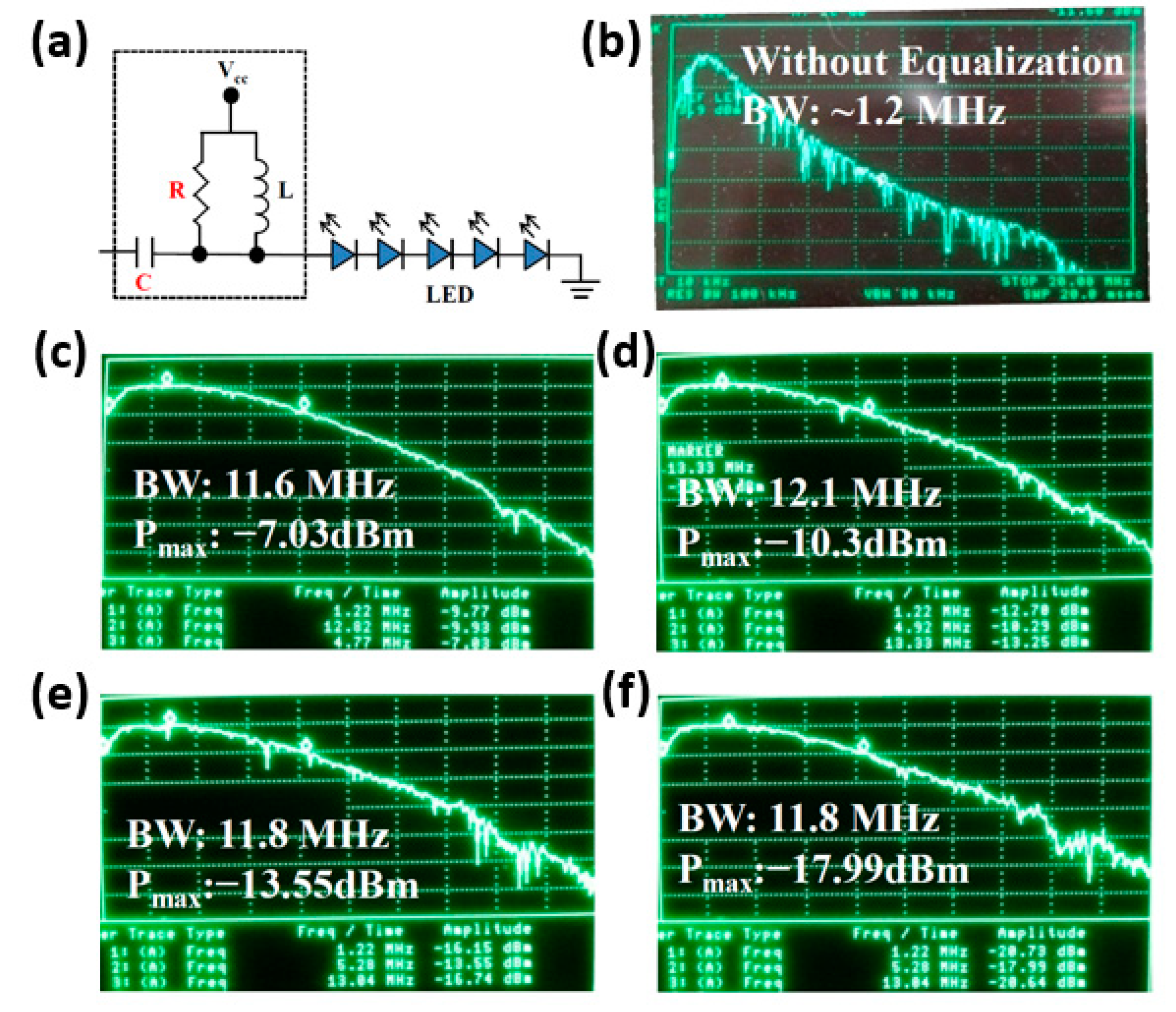
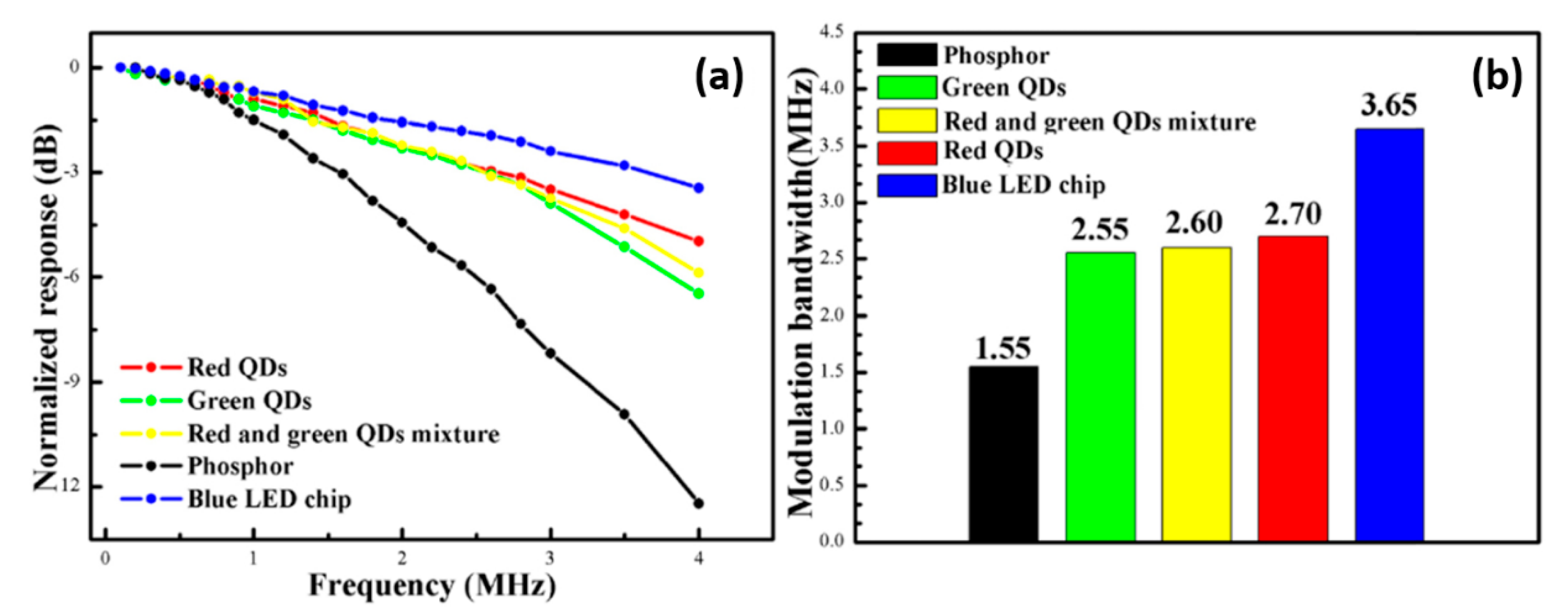
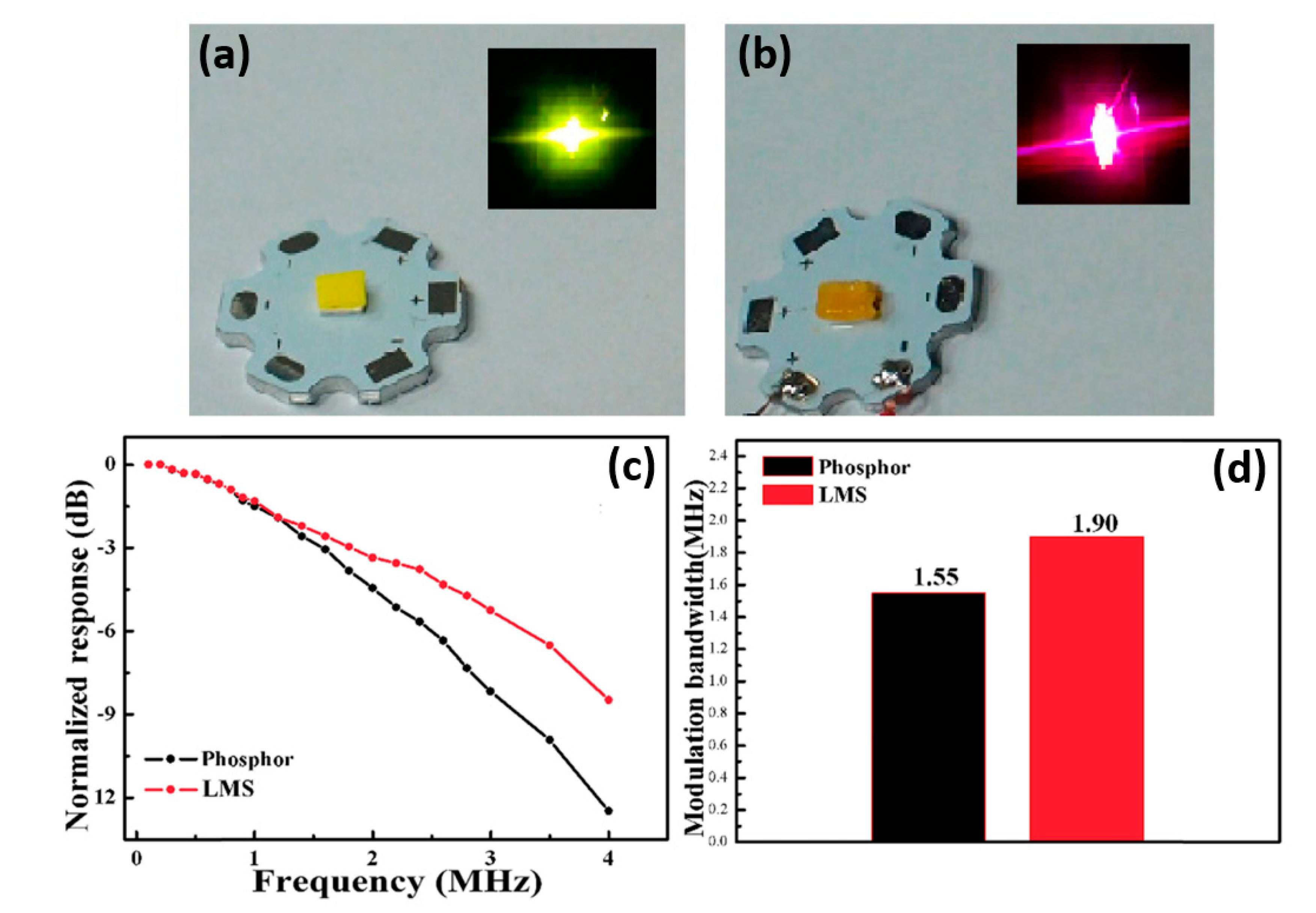
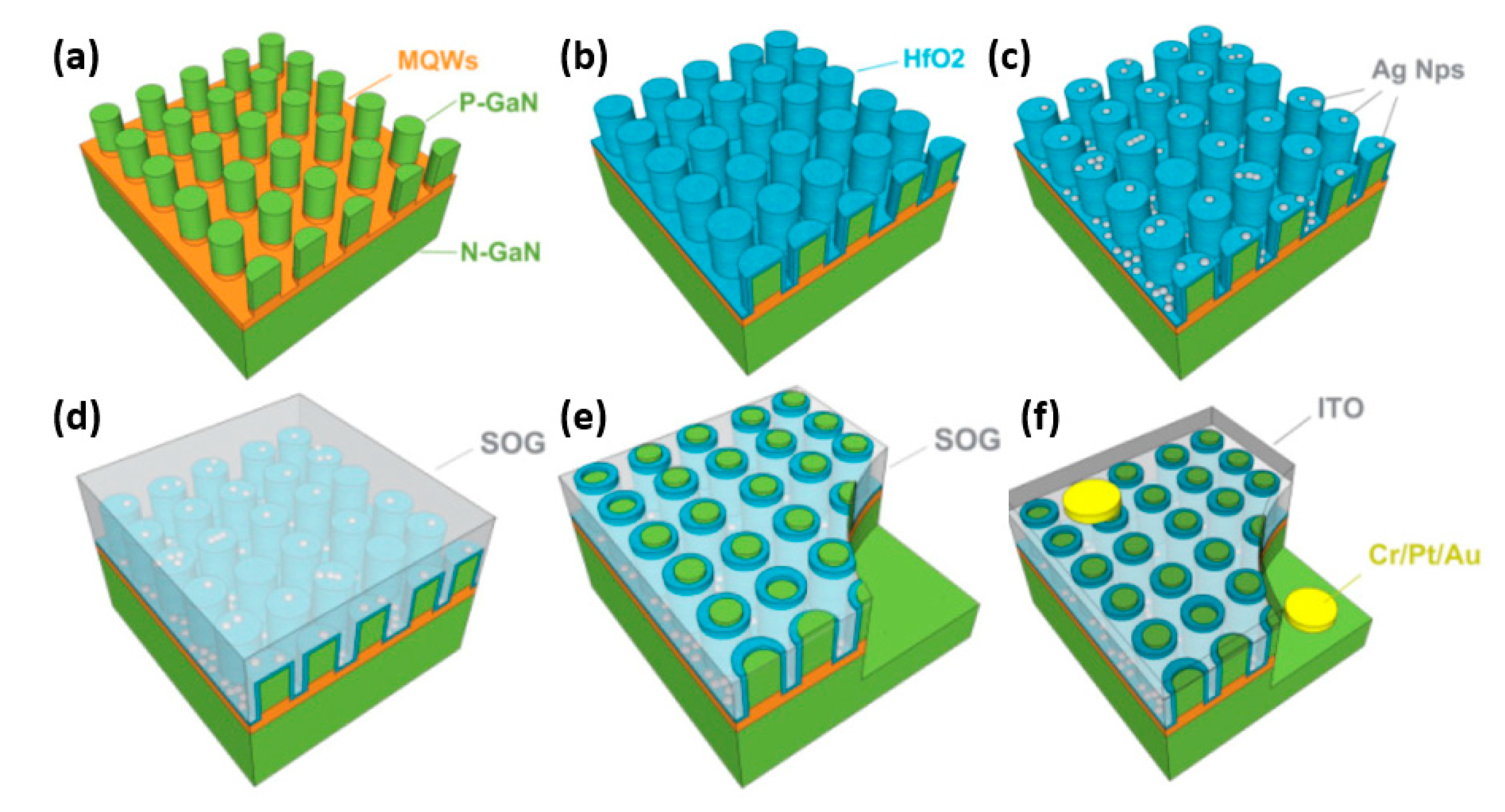
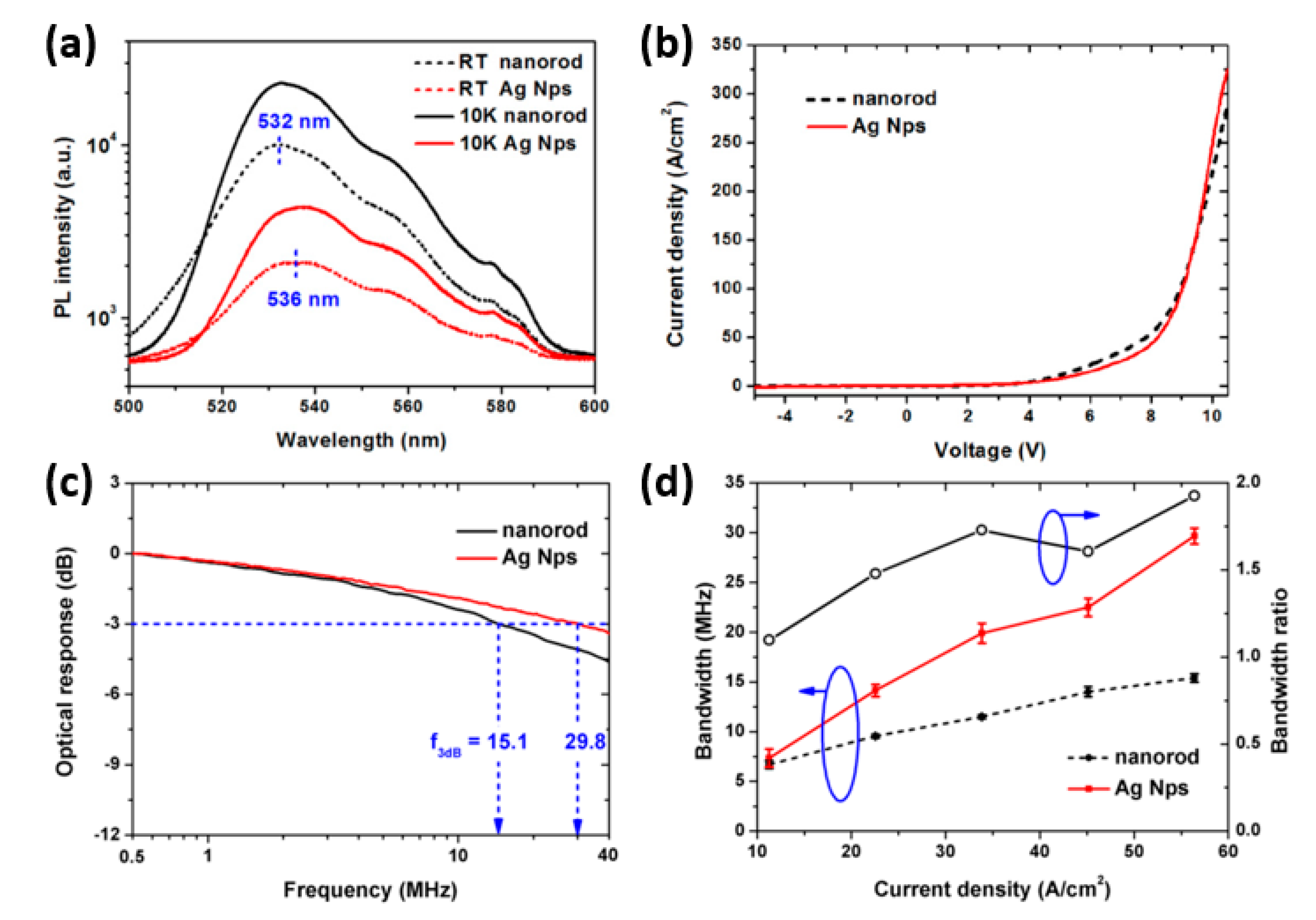
| Research Team | LED type | Drive Current | Bandwidth | Data Rate |
|---|---|---|---|---|
| Dinh et al. [57] Huang Chen et al. [60] Hagger et al. [59] Quan et al. [62] Chao Shen et al. [63] Corbett et al. [64] Khoury et al. [65] | (11-22) InGaN/GaN blue LED (20-21) InGaN/GaN green LED (11-22) InGaN/GaN green LED (11-22) InGaN/GaN blue LED (20-2-1) InGaN/GaN super luminescent diode (11-22) green LED on GaN template (20-21) white InGaN LED on GaN/Sapphire template | 4 mA 40 mA 92 A/cm2 20 mA 600 mA 30 mA 2 kA/cm2 | 1030 MHz 756 MHz 540 MHz 150 MHz 560 MHz 100 MHz 660 MHz | 2.4 Gbps 1.5 Gbps --- 300 Mbps --- --- --- |
Publisher’s Note: MDPI stays neutral with regard to jurisdictional claims in published maps and institutional affiliations. |
© 2020 by the authors. Licensee MDPI, Basel, Switzerland. This article is an open access article distributed under the terms and conditions of the Creative Commons Attribution (CC BY) license (http://creativecommons.org/licenses/by/4.0/).
Share and Cite
James Singh, K.; Huang, Y.-M.; Ahmed, T.; Liu, A.-C.; Huang Chen, S.-W.; Liou, F.-J.; Wu, T.; Lin, C.-C.; Chow, C.-W.; Lin, G.-R.; et al. Micro-LED as a Promising Candidate for High-Speed Visible Light Communication. Appl. Sci. 2020, 10, 7384. https://doi.org/10.3390/app10207384
James Singh K, Huang Y-M, Ahmed T, Liu A-C, Huang Chen S-W, Liou F-J, Wu T, Lin C-C, Chow C-W, Lin G-R, et al. Micro-LED as a Promising Candidate for High-Speed Visible Light Communication. Applied Sciences. 2020; 10(20):7384. https://doi.org/10.3390/app10207384
Chicago/Turabian StyleJames Singh, Konthoujam, Yu-Ming Huang, Tanveer Ahmed, An-Chen Liu, Sung-Wen Huang Chen, Fang-Jyun Liou, Tingzhu Wu, Chien-Chung Lin, Chi-Wai Chow, Gong-Ru Lin, and et al. 2020. "Micro-LED as a Promising Candidate for High-Speed Visible Light Communication" Applied Sciences 10, no. 20: 7384. https://doi.org/10.3390/app10207384
APA StyleJames Singh, K., Huang, Y.-M., Ahmed, T., Liu, A.-C., Huang Chen, S.-W., Liou, F.-J., Wu, T., Lin, C.-C., Chow, C.-W., Lin, G.-R., & Kuo, H.-C. (2020). Micro-LED as a Promising Candidate for High-Speed Visible Light Communication. Applied Sciences, 10(20), 7384. https://doi.org/10.3390/app10207384










